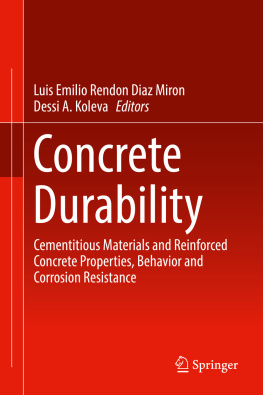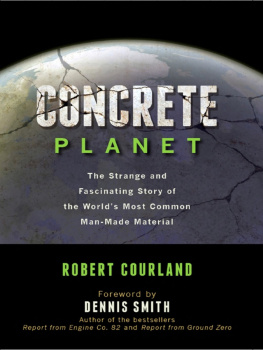
A couple years ago, a close friend asked me what kind of book I was working on. I told him, It's the story of concrete. He gave me a strange look and then a sly smile and said, Right! Seriously, what is your book really about?
I kept thinking about my friend's reaction after I began submitting my book proposal to literary agents, most of whom seemed to have simply scanned the cover sheet before sending a rejection letter or e-mail. For this reason, I am especially grateful to Barbara Braun of the Barbara Braun Literary Agency for taking the time to read the proposal and for deciding that the book was interesting enough for her to represent me. Representing a book on this theme was hardly an easy task for Barbara (good agents earn every penny of their commissions), but she did find someone who was willing to take the time to read the proposal and the sample chapters and see the book's potential. This someone was Linda Regan, executive editor at Prometheus Books. Both Barbara and Linda have guided me through the process of researching and writing Concrete Planet, providing invaluable advice and solid direction. I am supremely grateful to both of them.
I would also like to take this opportunity to thank Bob Nason, whose hospitality, large library, and long experience (his structural damage assessment of the 1906 earthquake and fire for the United States Geological Survey proved invaluable) contributed greatly to this book. My friend, Randolph Langenbach, an eminent architect and author who has also studied the structural damage caused to both masonry and reinforced concrete buildings in earthquakes around the world, reviewed an early draft of the book and made a number of very useful suggestions that helped to improve the clarity of the text.
Another person to whom I owe thanks is fellow writer Dennis Smith. We were having a discussion over lunch one day when I mentioned the incredible material I had unearthed about problems related to reinforced concrete. I also expressed qualms about doing a book about the subject, since I was neither a civil engineer nor an architect. That's why you need to write the book, he said. You don't have a career to lose. I am glad I took his advice.
The most pleasant aspect of writing Concrete Planet was the tremendous assistance I received from many generous individuals around the world who took the time to send me material and images, much of which were unavailable from libraries, photo archives, or Internet sources. Among the people I would like to thank in this regard are Dr. Manfred Schmidt, Dr. Patty Jo Watson, Dr. Richard Anderson, Dr. Mehmet zdoan, Kate Tarasenko, Emilio Labrador, Christopher Newberry, Martin Olsson, Martha Fox, and many others. I am also grateful to Gladys and Richard Hansen for allowing me access to the archives of the Museum of the City of San Francisco, which provided some very obscure but very important material. The museum, which runs one of the best historical websites in the United States, has suffered from the recent economic upheavals. Those wishing to help this fine institution by making a donation should go to http://www.sfmuseum.org.
I would also like to thank Dr. Michael Kapphahn for helping me track down important historical papers and articles in Germany about the last years of William Aspdin. The Library of Congress, as always, has been extraordinarily helpful. It is regrettable that so many other institutions, many of which are financially well-endowed, do not possess the same spirit of open cooperation.
I would like to also thank Julia Sandison for the images of the Hockley Viaduct. Her small volunteer group, Friends of the Hockley Viaduct, is fighting hard to save the viaductperhaps the most beautiful and architecturally significant surviving concrete structure of the nineteenth centuryfrom vandals and neglect. English Heritage declined to include the viaduct.
Though he is no longer with us, I would like to thank the late Major A. C. Francis, the British historian of modern concrete's early days. Without the results of his dogged research, much of chapters 5 and 6 would have been very different, and certainly less accurate.
Finally, this book would have been impossible to write without the continual encouragement, research assistance, and translation work provided by my wife, Josephine. Words are an inadequate medium in which to express my deep appreciation and love for her.

Israeli geologists caused a minor stir in the 1960s when they announced the discovery of a concrete compound in a twelve-million-year-old rock formation in the Negev desert. This news raised eyebrows, particularly among engineering historians, archaeologists, and paleontologists, for the discovery predated not only the earliest known use of concrete but also the earliest known hominids. Twelve million years ago, our ancestors were hardly more advanced than today's lemurs. Who made the concrete?
Predictably, the facts are less sensational than the headlines. The pseudo-concrete was created when geologic forces gradually brought a limestone outcrop into contact with oil shale and, with water as a catalyst, produced a natural cement compound. This compound would not be considered concrete by chemists or engineers; rather, it could more accurately be described as bad asphalt. For this reason, I think it best to confine our examination of concrete's origins to those early human societies whose approach to its invention, while sometimes not quite scientific, was more methodical and successful than Nature's random products.
Because limesometimes called quicklimeis the essential ingredient of concrete, it is perhaps best to begin our story with the discovery of that remarkable substance. Lime is derived from the principal component of limestone: calcium carbonate. Limestone is created from the physical remains of countless generations of corals and shellfish that eventually formed a thick sedimentary layer. This layer was eventually crushed and crystallized by powerful geologic forces, resulting in a whitish rock. Pick up a sun-bleached seashell lying on the beach, and you are, in effect, holding a pure form of lime-stone, for the shell consists almost entirely of calcium carbonate. Limestone in its abundance provides silent testimony to the massive volume of life that thrived in the oceans for hundreds of millions of years before human beings came into existence. And those human beings would eventually discover that limestone contained hidden properties that, to their primitive eyes, seemed nothing short of miraculous. Even for us today, long inured to technical wonders, these properties still seem a little eerie and preternatural.
We now know that lime was discovered sometime toward the end of the Paleolithic Age, approximately twelve thousand years ago. The Paleolithic (Old Stone) Age reaches back almost three million years, and technically begins with the first stone tools. Consequently, it encompasses both the hominids and anatomically modern humans who used stone tools. For Homo sapiens, the Paleolithic Age begins with our species, approximately two hundred thousand years ago.
Until the invention of carbon-14 analysis and other sophisticated dating technologies, it was often difficult for archaeologists to differentiate the age of objects found at various sites where our Paleolithic ancestors once lived. Were the objects one hundred thousand years old? Sixty thousand years old? There was sometimes not enough variation among the artifacts to easily chart a firm evolutionary path in toolmaking. For us, technological breakthroughs happen constantly within a single lifetime; for our hunter-gatherer ancestors, they took place perhaps once every hundred generations or more. For most of our existence on this planet, we were pretty slow on the uptake when it came to technology.
Next page









